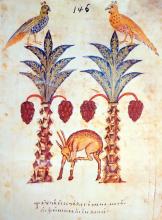Cosmas Indicopleustes
Byzantine author who lived and worked in the first half of the 6th century and he practiced merchant in Alexandria. He toured around 520 the surrounding areas of Egypt (Red Sea, Arabia, etc.) and traveled to the Black Sea, in East Africa, in India, in Ceylon. However it is considered by many if certainly arrived in India.
The surname of the Indicopleustes is not listed in the codes containing his work, but mentioned only in the 11th century. According to the tradition, he retired after the tours of the monastery Sinai, which took place around 535, and dealt with the writing of his impressions.
His work entitled Christian Topography (Χριστιανική Τοπογραφία) consists of twelve books. The content of this project, as naughty patchwork of different news, fails the title, but aims to propagate the biblical view of the world and openly rejects the cosmological model of Ptolemy as false and heretical. This presupposes that the universe is a measure of volume box with lid upper sky. The land is elongated valley, which is housed by the celestial dome and surrounded by the ocean, beyond which Heaven placed. To the north, around a conical term moving the astral world, which sometimes approaches the top of the mountain and sometimes its base.
Cosmas was probably an adherent of Nestorianism. As to the theological ideas contained in the Christian Topography, Cosmas followed the teachings of Theodore of Mopsuestia, Diodorus Bishop of Tarsus (378-392) and Severianus of Gavala.
Apart from the above project, Cosmas wrote and others which do not have survived: Geography, Astronomy and Comments in the Bible (which may be part of the Christian Topography, including: Introduction to the Psalms, Introduction to the Evangelists, Life of the Evangelists).
The work of Cosmas Indicopleustes is not so important for the expression of theological ideas and the world of nature concepts, as for the content in this valuable and accurate geographical and cultural information for the countries which toured and are either conceived by same site or listened by others. Reliable is the information on Huns, who inhabited the north of India.
The Christian Topography written in simple language and decorated with geographical and cosmography drawings, assessed and read by the Byzantines, among which was the Patriarch Photius (827-891, codex 36), in whose library there were comments for its. The ideas and content studied and commented on by many scholars.
SOURCES
A.P. Kazhdan, The Oxford Dictionary of Byzantium, New York and Oxford 1991 1151-1152.
Catholic Encyclopedia: Cosmas Indicopleustes. Available at: http://www.newadvent.org/ (Accessed: 17 February 2015).
SELECTED BIBLIOGRAPHY
W. Wolska-Conus, La Topographie chrétienne de Cosmas Indicopleustes: théologie et sciences au VIe siècle, Paris 1962.
S. A. Faller, «The World According to Cosmas Indicopleustes – Concepts and Illustrations of an Alexandrian Merchant and Monk », Transcultural Studies 1, 2011, p. 193-232, available at: <http://journals.ub.uni-heidelberg.de/index.php/transcultural/article/view/6127/2962>. Date accessed: 09 Jul. 2015. doi:http://dx.doi.org/10.11588/ts.2011.1.6127.


